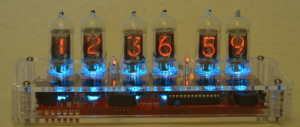That which came second
The Spectrum Clock
I wanted to build something using larger tubes. I chose the IN-18 tubes (originally made in The Ukraine by Gazotron) which have a digit height of around 40mm. Some ebay research resulted in a package being delivered from The Ukraine.
The Spectrum build is actually simpler than the QTC, resistor networks help reduce the component count and as the board is bigger, everything is a little more spread out.
The initial tube test confirmed that all is well, next up was the circuitry for the RGB LED’s (which illuminate the tubes if desired) and the various switches and sockets which are used to control the completed clock.
A useful addition is the optional PIR detector which will switch the clock on for a pre-determined period when activated. This means that the tubes are powered only when someone is there to look at them, thus preserving the life of these vintage items!
The finished clock now sits proudly in the family room and is admired by all – especially me!
That which came first
The QTC Clock
After researching the various tube types and options, I settled on a kit featuring with ZM1210 tubes. The ZM1210’s were manufactured by Telefunken in Germany and come with a nice red coating (which can be removed if desired).
This is a really nice kit which will support a variety of different tube types. It features tubes mounted on carriers which can be changed easily (Quick Tube Change) in case of failure.
The well produced PCB is nicely laid out and features all manner of components including resistors, capacitors, inductors, transistors, a PIC micro controller and specialist tube driver IC’s.
The build process is well documented and the whole thing took about 10 hours (for the first one anyway!) to complete. Having never soldered anything before, Jo has completed most of her QTC construction in around 5 hours!




Recent Comments